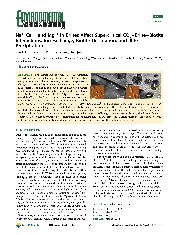摘要
For sustainable geologic CO2 sequestration (GCS), a better understanding of the effects of brine cation compositions on mica dissolution, surface morphological change, and secondary mineral precipitation under saline hydrothermal conditions is needed. Batch dissolution experiments were conducted with biotite under conditions relevant to GCS sites (55-95 degrees C and 102 atm CO2). One molar NaCl, 0.4 M MgCl2, or 0.4 M CaCl2 solutions were used to mimic different brine compositions, and deionized water was used for comparison. Faster ion exchange reactions (Na+-K+, Mg2+-K+, and Ca2+-K+) occurred in these salt solutions than in water (H+-K+). The ion exchange reactions affected bump, bulge, and crack formation on the biotite basal plane, as well as the release of biotite framework ions. In these salt solutions, numerous illite fibers precipitated after reaction for only 3 h at 95 degrees C. Interestingly, in slow illite precipitation processes, oriented aggregation of hexagonal nanoparticles forming the fibrous illite was observed. These results provide new information for understanding scCO(2)-brine-mica interactions in saline aquifers with different brine cation compositions, which can be useful for GCS as well as other subsurface projects.
- 出版日期2013-1-1
